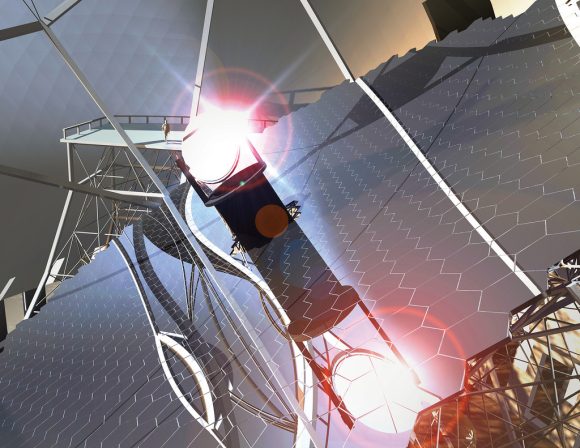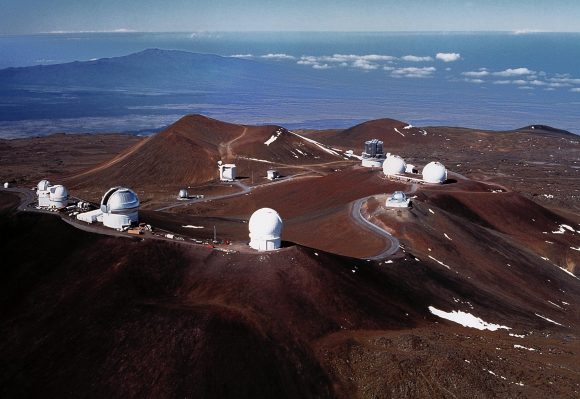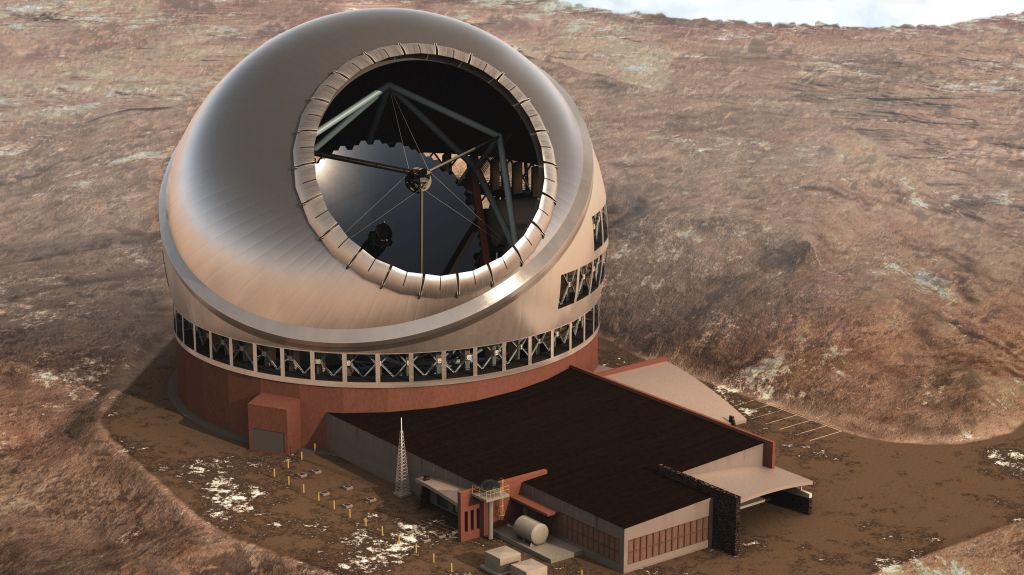As Carl Sagan said, “Understanding is Ecstasy.” But in order to understand the Universe, we need better and better ways to observe it. And that means one thing: big, huge, enormous telescopes.
In this series, we’ll look at six Super Telescopes being built:
- The Giant Magellan Telescope
- The Overwhelmingly Large Telescope
- 30 Meter Telescope
- The European Extremely Large Telescope
- Large Synoptic Survey Telescope
- James Webb Space Telescope
- The Wide Field Infrared Survey Telescope
The Thirty Meter Telescope
The Thirty Meter Telescope (TMT) is being built by an international group of countries and institutions, like a lot of Super Telescopes are. In fact, they’re proud of pointing out that the international consortium behind the TMT represents almost half of the world’s population; China, India, the USA, Japan, and Canada. The project needs that many partners to absorb the cost; an estimated $1.5 billion.
The heart of any of the world’s Super Telescopes is the primary mirror, and the TMT is no different. The primary mirror for the TMT is, obviously, 30 meters in diameter. It’s a segmented design consisting of 492 smaller mirrors, each one a 1.4 meter hexagon.
The light collecting capability of the TMT will be 10 times that of the Keck Telescope, and more than 144 times that of the Hubble Space Telescope.
But the TMT is more than just an enormous ‘light bucket.’ It also excels with other capabilities that define a super telescope’s effectiveness. One of those is what’s called diffraction-limited spatial resolution (DLSR).

When a telescope is pointed at distant objects that appear close together, the light from both can scatter enough to make the two objects appear as one. Diffraction-limited spatial resolution means that when a ‘scope is observing a star or other object, none of the light from that object is scattered by defects in the telescope. The TMT will more easily distinguish objects that are close to each other. When it comes to DLSR, the TMT will exceed the Keck by a factor of 3, and will exceed the Hubble by a factor of 10 at some wavelengths.
Crucial to the function of large, segmented mirrors like the TMT is active optics. By controlling the shape and position of each segment, active optics allows the primary mirror to compensate for changes in wind, temperature, or mechanical stress on the telescope. Without active optics, and its sister technology adaptive optics, which compensates for atmospheric disturbance, any telescope larger than about 8 meters would not function properly.
The TMT will operate in the near-ultraviolet, visible, and near-infrared wavelengths. It will be smaller than the European Extremely Large Telescope (E-ELT), which will have a 39 meter primary mirror. The E-ELT will operate in the optical and infrared wavelengths.
The world’s Super Telescopes are behemoths. Not just in the size of their mirrors, but in their mass. The TMT’s moving mass will be about 1,420 tonnes. Moving the TMT quickly is part of the design of the TMT, because it must respond quickly when something like a supernova is spotted. The detailed science case calls for the TMT to acquire a new target within 5 to 10 minutes.
This requires a complex computer system to coordinate the science instruments, the mirrors, the active optics, and the adaptive optics. This was one of the initial challenges of the TMT project. It will allow the TMT to respond to transient phenomena like supernovae when spotted by other telescopes like the Large Synoptic Survey Telescope.
The Science
The TMT will investigate most of the important questions in astronomy and cosmology today. Here’s an overview of major topics that the TMT will address:
- The Nature of Dark Matter
- The Physics of Extreme Objects like Neutron Stars
- Early galaxies and Cosmic Reionization
- Galaxy Formation
- Super-Massive Black Holes
- Exploration of the Milky Way and Nearby Galaxies
- The Birth and Early Lives of Stars and Planets
- Time Domain Science: Supernovae and Gamma Ray Bursts
- Exo-planets
- Our Solar System
This is a comprehensive list of topics, to be sure. It leaves very little out, and is a testament to the power and effectiveness of the TMT.
The raw power of the TMT is not in question. Once in operation it will advance our understanding of the Universe on multiple fronts. But the actual location of the TMT could still be in question.
Where Will the TMT Be Built?
The original location for the TMT was Mauna Kea, the 4,200 meter summit in Hawaii. Mauna Kea is an excellent location, and is the home of several telescopes, most notably the Keck Observatory, the Gemini Telescope, the Subaru Telescope, the Canada-France-Hawaii Telescope, and the James Clerk Maxwell Telescope. Mauna Kea is also the site of the westernmost antenna of the Very Long Baseline Array.

The dispute between some of the Hawaiian people and the TMT has been well-documented elsewhere, but the basic complaint about the TMT is that the top of Mauna Kea is sacred land, and they would like the TMT to be built elsewhere.
The organizations behind the TMT would still like it to be built at Mauna Kea, and a legal process is unfolding around the dispute. During that process, they identified several possible alternate sites for the telescope, including La Palma in the Canary Islands. Universe Today contacted TMT Observatory Scientist Christophe Dumas, PhD., about the possible relocation of the TMT to another site.
Dr. Dumas told us that “Mauna Kea remains the preferred location for the TMT because of its superb observing conditions, and because of the synergy with other TMT partner facilities already present on the mountain. Its very high elevation of almost 14,000 feet makes it the premier astronomical site in the northern hemisphere. The sky above Mauna Kea is very stable, which allows very sharp images to be obtained. It has also excellent transparency, low light pollution and stable cold temperatures that improves sensitivity for observations in the infrared.”
The preferred secondary site at La Palma is home to over 10 other telescopes, but would relocation to the Canary Islands affect the science done by the TMT? Dr. Dumas says that the Canary Islands site is excellent as well, with similar atmospheric characteristics to Mauna Kea, including stability, transparency, darkness, and fraction of clear-nights.

As Dr. Dumas explains, “La Palma is at a lower elevation site and on average warmer than Mauna Kea. These two factors will reduce TMT sensitivity at some wavelengths in the infrared region of the spectrum.”
Dr. Dumas told Universe Today that this reduced sensitivity in the infrared can be overcome somewhat by scheduling different observing tasks. “This specific issue can be partly mitigated by implementing an adaptive scheduling of TMT observations, to match the execution of the most demanding infrared programs with the best atmospheric conditions above La Palma.”
Court Proceedings End
On March 3rd, 44 days of court hearings into the TMT wrapped up. In that time, 71 people testified for and against the TMT being constructed on Mauna Kea. Those against the telescope say that the site is sacred land and shouldn’t have any more telescope construction on it. Those for the TMT spoke in favor of the science that the TMT will deliver to everyone, and the education opportunities it will provide to Hawaiians.
Though construction has been delayed, and people have gone to court to have the project stopped, it seems like the TMT will definitely be built—somewhere. The funding is in place, the design is finalized, and manufacturing of the components is underway. The delays mean that the TMT’s first light is still uncertain, but once we get there, the TMT will be another game-changer, just like the world’s other Super Telescopes.


Why don’t they build it in PIco Island? It’s higher than Las Palmas and in the middle of the Atlantic in the Azores… https://en.wikipedia.org/wiki/Mount_Pico